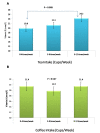Tea and coffee consumption in relation to vitamin D and calcium levels in Saudi adolescents
- PMID: 22905922
- PMCID: PMC3478213
- DOI: 10.1186/1475-2891-11-56
Tea and coffee consumption in relation to vitamin D and calcium levels in Saudi adolescents
Abstract
Background: Coffee and tea consumption was hypothesized to interact with variants of vitamin D-receptor polymorphisms, but limited evidence exists. Here we determine for the first time whether increased coffee and tea consumption affects circulating levels of 25-hydroxyvitamin D in a cohort of Saudi adolescents.
Methods: A total of 330 randomly selected Saudi adolescents were included. Anthropometrics were recorded and fasting blood samples were analyzed for routine analysis of fasting glucose, lipid levels, calcium, albumin and phosphorous. Frequency of coffee and tea intake was noted. 25-hydroxyvitamin D levels were measured using enzyme-linked immunosorbent assays.
Results: Improved lipid profiles were observed in both boys and girls, as demonstrated by increased levels of HDL-cholesterol, even after controlling for age and BMI, among those consuming 9-12 cups of coffee/week. Vitamin D levels were significantly highest among those consuming 9-12 cups of tea/week in all subjects (p-value 0.009) independent of age, gender, BMI, physical activity and sun exposure.
Conclusion: This study suggests a link between tea consumption and vitamin D levels in a cohort of Saudi adolescents, independent of age, BMI, gender, physical activity and sun exposure. These findings should be confirmed prospectively.
Figures
Similar articles
-
Vitamin D deficiency and calcium intake in reference to increased body mass index in children and adolescents.Eur J Pediatr. 2012 Jul;171(7):1081-6. doi: 10.1007/s00431-012-1686-8. Epub 2012 Feb 7. Eur J Pediatr. 2012. PMID: 22311168
-
Prevalence of lifestyle practices that might affect bone health in relation to vitamin D status among female Saudi adolescents.Nutrition. 2018 Jan;45:108-113. doi: 10.1016/j.nut.2017.07.015. Epub 2017 Aug 4. Nutrition. 2018. PMID: 29129230
-
Increased vitamin D supplementation recommended during summer season in the gulf region: a counterintuitive seasonal effect in vitamin D levels in adult, overweight and obese Middle Eastern residents.Clin Endocrinol (Oxf). 2012 Mar;76(3):346-50. doi: 10.1111/j.1365-2265.2011.04219.x. Clin Endocrinol (Oxf). 2012. PMID: 21906116
-
Vitamin D Deficiency and Cardiometabolic Risks: A Juxtaposition of Arab Adolescents and Adults.PLoS One. 2015 Jul 17;10(7):e0131315. doi: 10.1371/journal.pone.0131315. eCollection 2015. PLoS One. 2015. PMID: 26186591 Free PMC article.
-
Coffee and tea: perks for health and longevity?Curr Opin Clin Nutr Metab Care. 2013 Nov;16(6):688-97. doi: 10.1097/MCO.0b013e328365b9a0. Curr Opin Clin Nutr Metab Care. 2013. PMID: 24071782 Review.
Cited by
-
Impact of Vitamin D Status on Cardiometabolic Complications among Children and Adolescents with Type 1 Diabetes Mellitus.J Clin Res Pediatr Endocrinol. 2016 Mar 5;8(1):48-54. doi: 10.4274/jcrpe.2266. Epub 2015 Dec 18. J Clin Res Pediatr Endocrinol. 2016. PMID: 26757741 Free PMC article.
-
The effect of beverage temperature on the surface roughness, microhardness, and color stability of the monoshade composite resin: An in vitro study.Saudi Dent J. 2024 May;36(5):740-744. doi: 10.1016/j.sdentj.2024.03.002. Epub 2024 Mar 6. Saudi Dent J. 2024. PMID: 38766290 Free PMC article.
-
Caffeine Administration in Piglets with Low Birthweight and Low Vitality Scores, and Its Effect on Physiological Blood Profile, Acid-Base Balance, Gas Exchange, and Infrared Thermal Response.Animals (Basel). 2023 Nov 12;13(22):3491. doi: 10.3390/ani13223491. Animals (Basel). 2023. PMID: 38003109 Free PMC article.
-
Nationality, Gender, Age, and Body Mass Index Influences on Vitamin D Concentration among Elderly Patients and Young Iraqi and Jordanian in Jordan.Biochem Res Int. 2016;2016:8920503. doi: 10.1155/2016/8920503. Epub 2016 Mar 24. Biochem Res Int. 2016. PMID: 27110402 Free PMC article.
-
Caffeine Sources and Consumption among Saudi Adults Living with Diabetes and Its Potential Effect on HbA1c.Nutrients. 2021 Jun 7;13(6):1960. doi: 10.3390/nu13061960. Nutrients. 2021. PMID: 34200398 Free PMC article.
References
-
- Food and Agricultural Organization. Food balance sheets. http://www.fao.org.
-
- Spiller MA. Caffeine. Boca Raton: CRC Press; 1998. The chemical components of coffee; pp. 97–161.
-
- HealthCanada. Fact Sheet Caffeine and Your Health. 2003. http://www.hc-sc.gc.ca/foodaliment/dg/ecaffeine.html.
MeSH terms
Substances
LinkOut - more resources
Full Text Sources
Medical


